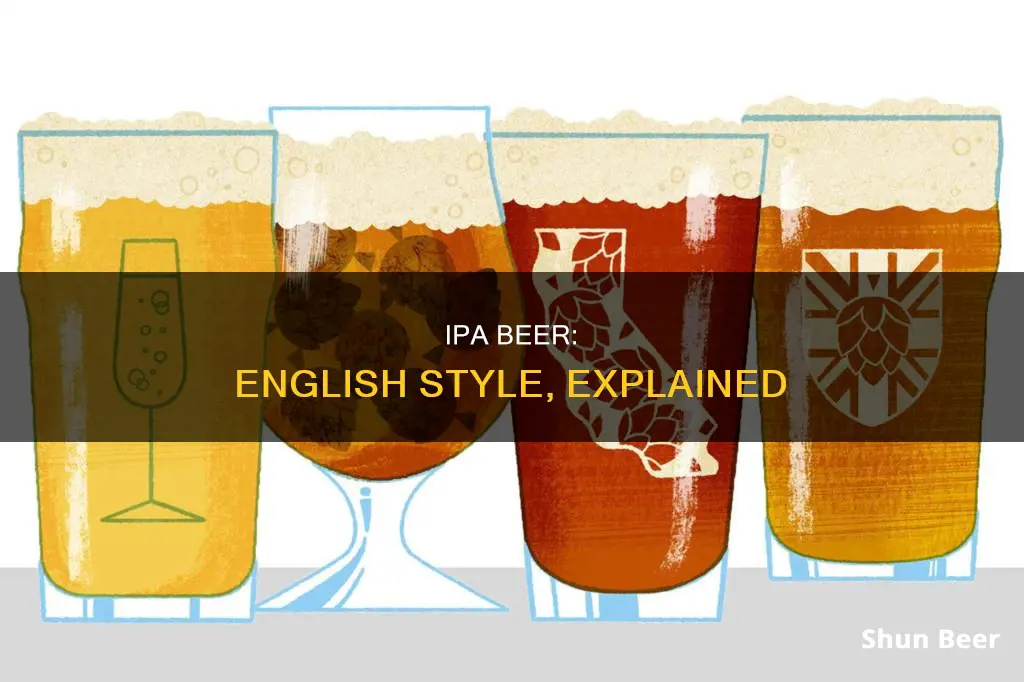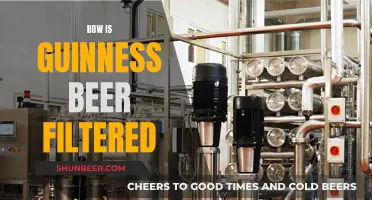
India Pale Ale (IPA) is a hoppy, bitter, and strong beer style within the broader category of pale ales. It was originally an export beer shipped to India during the British colonial era, when the journey took months and beers had to be tweaked to withstand the voyage. IPAs were made maltier, with higher alcohol content, and more hops, which acted as a natural preservative. Over time, taxation has caused the English IPA to have a lower alcohol content, and modern examples are often weaker than traditional IPAs. English IPAs are known for their earthy, floral, and fruity notes, with a malt profile defined by biscuit, toast, and toffee flavours.
| Characteristics | Values |
|---|---|
| Alcohol Content | 4.5–7.0% ABV |
| Bitterness | 35–60 IBU |
| Glassware | Pint Glass, Becker, Nonic, Tumbler |
| Colour | Golden to Deep Amber |
| Clarity | Clear, but may be hazy if unfiltered |
| Head | Moderate-sized, persistent, off-white colour |
| Hop Aroma | Moderate to moderately-high, floral, spicy-peppery, citrus-orange, slightly grassy |
| Malt Presence | Moderately-low, caramel-like, toasty |
| Fruitiness | Low to moderate |
| Sulfury Note | May be present |
| Hop Flavor | Medium to high, similar to the aroma |
| Malt Flavor | Medium-low to medium, bready, biscuit-like, toasty, toffee-like, caramelly |
| Mouthfeel | Smooth, medium-light to medium-bodied |
| Carbonation | Moderate to medium-high |
What You'll Learn

History of English IPAs
The history of English IPAs, or India Pale Ales, goes back to the late 18th century when British brewers were looking for a way to preserve beer during long voyages to India. The beer that was being exported to India, a dark mild porter, would spoil and go flat during the journey.
George Hodgson, a brewer at the Bow Brewery in East London, is generally credited with creating the first IPA in the 1780s. He began sending his "October beer", a strong, heavily hopped and high-alcohol pale ale, to India. The hops and alcohol content helped preserve the beer during its long journey and created a bitter and refreshing drink that was better suited to India's hot climate.
Hodgson's beer was soon imitated by bigger brewers such as Bass, and the style evolved into something weaker for the domestic market. By the early 19th century, "pale ale prepared for the India market" was gaining popularity as exports increased, and by the 1830s, India Pale Ale had become one of England's best-selling beers.
However, with the advent of commercial refrigeration in the late 19th century, which revolutionised the shipping of perishable goods, IPAs became less common. It wasn't until almost two centuries later that Americans revived the style with the cultivation of a new type of hops, Cascade hops, which were released in 1972. This led to the creation of the first American pale ales and sparked a craft beer revolution in the US. The popularity of IPAs eventually spread back across the Atlantic, and they have since returned to their country of origin and become fashionable once more in Britain.
The History of IPA Beer: What Does IPA Stand For?
You may want to see also

English IPA characteristics
English India Pale Ale (or English IPA) is a stronger version of a pale ale. It is characterised by a generous amount of English hop character (earthy, floral) and increased alcohol content. English yeast lends a fruity character to the flavour and aroma, contrasting the earthy English hop additions. English IPAs strike a balance between malt and hops for a more rounded flavour.
The colour of English IPAs ranges from golden to deep amber, but most are fairly pale. They should be clear, although unfiltered dry-hopped versions may be slightly hazy. The head should be moderate to moderately high and off-white in colour. The hop aroma is moderate to moderately high and can be floral, spicy-peppery, or citrus-orange in nature. A slightly grassy dry-hop aroma is also acceptable. The malt presence is moderately low to moderate and may be caramel-like or toasty. Some versions may have a sulfury note.
The hop flavour is medium to high, with a moderate to assertive bitterness. The hop flavour should be similar to the aroma. The malt flavour should be medium-low to medium and somewhat bready, with optional light to medium-light biscuit-like, toasty, toffee-like, and/or caramelly aspects. The finish is medium-dry to very dry, and the bitterness may linger into the aftertaste. The balance is towards the hops, but the malt should still be noticeable.
English IPAs are well-suited to pairing with food. They go well with strong English cheeses and grilled or braised meats, like pork. The higher alcohol content, hops, and carbonation cut through fat and cleanse the palate.
The Ultimate Guide to IPA Beer Perfection
You may want to see also

English IPA vs. American IPA
India Pale Ale (IPA) is a beer style that originated in England in the 18th century. The style has evolved over time, with different countries and regions adopting their own variations. Two of the most well-known variations are American IPA and English IPA. While both styles share a common history, American and English IPAs differ in their brewing methods, ingredients, and flavour profiles.
History and Background
India Pale Ale was originally brewed in England for export to India. The beer was heavily hopped and had a high alcohol content to help preserve it during its long journey by ship. The style gained popularity in England and eventually made its way to other countries, including the United States. American brewers put their own spin on the style, creating a hop-forward beer with a more aggressive flavour profile.
Key Differences
One of the main differences between American and English IPAs is the type of hops used. English IPAs typically feature English hop varieties such as Fuggles, Goldings, and East Kent Goldings, which have a more subtle flavour profile with earthy, herbal, and floral notes. On the other hand, American IPAs usually employ American hop varieties like Cascade, Centennial, and Simcoe, resulting in a more pungent flavour profile with citrus, pine, and resinous notes.
In addition to hops, English IPAs tend to use a more traditional malt bill, including English pale ale malt and specialty malts such as crystal and biscuit malts. American IPAs, however, may utilise a broader range of malt varieties, including American pale ale malt, wheat, and rye.
Yeast strains also differ between the two styles. English IPAs typically use an English ale yeast strain, contributing to the beer's fruity esters. In contrast, American IPAs often use a neutral yeast strain, allowing the hops to stand out more prominently.
Brewing Techniques
Brewing techniques vary between the two styles. American IPAs are often brewed with a higher alcohol content and a greater quantity of hops. They may also be dry-hopped, enhancing the hop flavour and aroma. English IPAs, on the other hand, are typically brewed with a lower alcohol content and a more balanced flavour profile. This style may be cask-conditioned, resulting in a softer mouthfeel and a more complex flavour profile.
Flavour Profile
The flavour profiles differ significantly between American and English IPAs. American IPAs are known for their intense hop flavour and aroma, with a pronounced bitterness. In contrast, English IPAs offer a more subtle hop flavour and aroma, with a balanced flavour profile that includes a noticeable but not overpowering hop bitterness. The hops used in English IPAs tend to have a more traditional taste and aroma, with earthy, herbal, and floral notes.
In summary, American IPAs are recognised for their bold, hop-forward flavour profile, while English IPAs exhibit a more balanced and subtle flavour. Both styles are popular among beer enthusiasts and can be enjoyed on their own or paired with various foods.
Michelob Ultra: An IPA Beer or Not?
You may want to see also

English IPA food pairings
The key to pairing food with English IPAs is to harmonise flavours, either by matching like for like or by contrasting them. The bitterness of an English IPA can be a challenge when it comes to food pairings, so your best bet is to opt for something fried and salty, like fried chicken, which will calm the bitterness and accentuate the malt profile of the beer.
English IPAs also go well with grilled meats, such as steaks and burgers, where the caramelisation of the meat will bring out the malty backbone of the beer. Similarly, the hop flavour will provide a nice umami contrast.
The aromatics of Thai food are a great match for an English IPA, especially a green curry, as the citrus flavours of the hops will complement the lemongrass and coriander in the dish. However, remember not to make the curry too spicy, or it will overpower the beer.
A blue cheese sauce is another good pairing with English IPAs. This classic sauce can be served with a variety of dishes, such as steaks, pastas, or chicken wings, and its texture and mild pungency will work well with the hop bitterness of the beer.
For dessert, a zesty lemon tart or a light, citrusy cake, such as Key lime or orange cake, can be a refreshing finish to a meal when paired with an English IPA. Again, avoid anything too bitter or aggressive; a lightly hopped session-strength beer will work best.
The Difference Between IPAs and XPAs: A Beer Style Guide
You may want to see also

English IPA glassware
When it comes to English IPA glassware, there are a few options to consider that can enhance your drinking experience. The type of glass you choose can impact not only the visual presentation of the beer but also how the aroma and flavours reach your palate.
Firstly, a standard pint glass is a classic choice for serving English IPAs. These glasses are typically durable, stackable, and easy to store, making them a popular option in pubs and bars. They have a wide mouth that allows for an easier flow of low ABV beers. However, the wide rim of a pint glass can cause aromas to blow off quickly, and they may not be ideal for capturing the complex flavours and aromas of an English IPA.
For a more specialised option, IPA glasses designed by beer masters or breweries themselves can provide an enhanced drinking experience. For example, the Spiegelau IPA glass, crafted in collaboration with Dogfish Head and Sierra Nevada, features a ridged, narrow bottom that agitates the beer and releases carbonation, creating a denser head that captures the aromas. This glass has a capacity of 18-19 ounces, providing ample room for the beer to breathe and develop a crown of foam. Its lightweight, non-leaded crystal construction delivers a high level of clarity, showcasing the hues of the beer.
Another option is a tulip-shaped glass, such as the Rastal Teku Stemmed Beer Glass. This style of glass is known for its ability to accentuate the aromas of more aromatic beers. The angular, modern shape helps trap the aromas, delivering a burst of flavours with each sip. The thin stem keeps your hand away from the bowl, preventing the warmth of your hand from affecting the beer's temperature. While this glass may be more delicate and require careful handling, it elevates the drinking experience for English IPAs.
Ultimately, the choice of glassware depends on personal preference and the specific characteristics of the English IPA you're enjoying. Each option presents a unique way to savour and appreciate the complex flavours, aromas, and appearance of this beloved beer style.
The Acidic Nature of IPAs: Beer's Sour Side
You may want to see also
Frequently asked questions
English India Pale Ale (or English IPA) is a hoppy, bitter, and strong variety of beer. It is a member of the English pale ale family and is characterised by its higher alcohol content and earthy, floral English hops.
English breweries exported a variety of beer styles to colonies across the British Empire. Shipping ales to troops in India was challenging as the journey took months and the beer needed to be preserved. To withstand the voyage, Pale Ales were made maltier, higher in alcohol content, and hoppier. The hops acted as a natural preservative.
IPA stands for India Pale Ale. The term "India" refers to the beer's association with the British Empire and its colonies in India.
English IPAs have a dry finish and a hoppy aroma and flavour. They range in colour from golden to deep amber but are typically fairly pale. They have a moderate to high hop bitterness and a moderate malt flavour.
English IPAs differ from American IPAs as they strike a balance between malt and hops, resulting in a more rounded flavour. English IPAs are also maltier, bitter, and one-noted in comparison to the popular fruity and crisp American IPAs.







